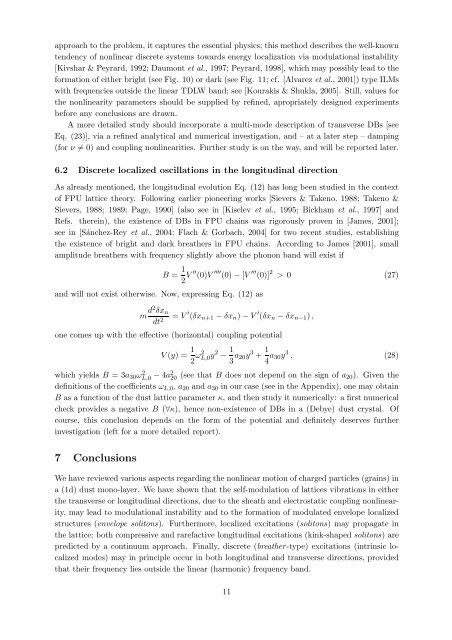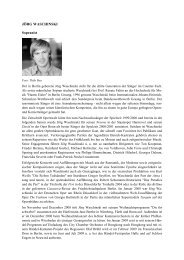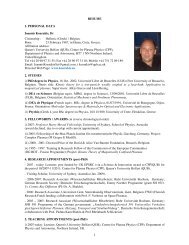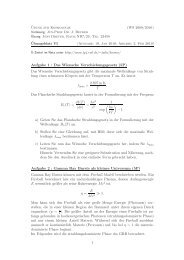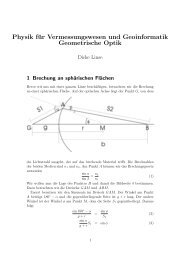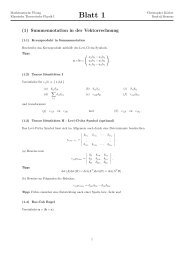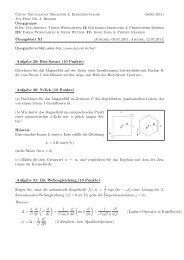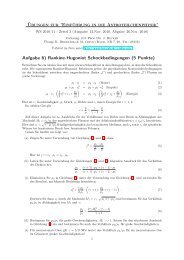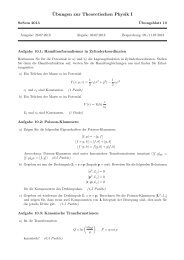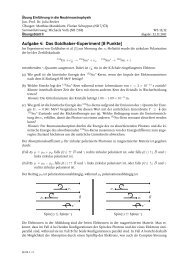View - Theoretische Physik IV - Ruhr-Universität Bochum
View - Theoretische Physik IV - Ruhr-Universität Bochum
View - Theoretische Physik IV - Ruhr-Universität Bochum
You also want an ePaper? Increase the reach of your titles
YUMPU automatically turns print PDFs into web optimized ePapers that Google loves.
approach to the problem, it captures the essential physics; this method describes the well-known<br />
tendency of nonlinear discrete systems towards energy localization via modulational instability<br />
[Kivshar & Peyrard, 1992; Daumont et al., 1997; Peyrard, 1998], which may possibly lead to the<br />
formation of either bright (see Fig. 10) or dark (see Fig. 11; cf. [Alvarez et al., 2001]) type ILMs<br />
with frequencies outside the linear TDLW band; see [Kourakis & Shukla, 2005]. Still, values for<br />
the nonlinearity parameters should be supplied by refined, apropriately designed experiments<br />
before any conclusions are drawn.<br />
A more detailed study should incorporate a multi-mode description of transverse DBs [see<br />
Eq. (23)], via a refined analytical and numerical investigation, and – at a later step – damping<br />
(for ν ≠ 0) and coupling nonlinearities. Further study is on the way, and will be reported later.<br />
6.2 Discrete localized oscillations in the longitudinal direction<br />
As already mentioned, the longitudinal evolution Eq. (12) has long been studied in the context<br />
of FPU lattice theory. Following earlier pioneering works [Sievers & Takeno, 1988; Takeno &<br />
Sievers, 1988; 1989; Page, 1990] (also see in [Kiselev et al., 1995; Bickham et al., 1997] and<br />
Refs. therein), the existence of DBs in FPU chains was rigorously proven in [James, 2001];<br />
see in [Sánchez-Rey et al., 2004; Flach & Gorbach, 2004] for two recent studies, establishing<br />
the existence of bright and dark breathers in FPU chains. According to James [2001], small<br />
amplitude breathers with frequency slightly above the phonon band will exist if<br />
and will not exist otherwise. Now, expressing Eq. (12) as<br />
B = 1 2 V ′′ (0)V ′′′′ (0) − [V ′′′ (0)] 2 > 0 (27)<br />
m d2 δx n<br />
dt 2 = V ′ (δx n+1 − δx n ) − V ′ (δx n − δx n−1 ),<br />
one comes up with the effective (horizontal) coupling potential<br />
V (y) = 1 2 ω2 L,0y 2 − 1 3 a 20y 3 + 1 4 a 30y 3 , (28)<br />
which yields B = 3a 30 ω 2 L,0 − 4a2 20 (see that B does not depend on the sign of a 20). Given the<br />
definitions of the coefficients ω L,0 , a 20 and a 30 in our case (see in the Appendix), one may obtain<br />
B as a function of the dust lattice parameter κ, and then study it numerically: a first numerical<br />
check provides a negative B (∀κ), hence non-existence of DBs in a (Debye) dust crystal. Of<br />
course, this conclusion depends on the form of the potential and definitely deserves further<br />
investigation (left for a more detailed report).<br />
7 Conclusions<br />
We have reviewed various aspects regarding the nonlinear motion of charged particles (grains) in<br />
a (1d) dust mono-layer. We have shown that the self-modulation of lattices vibrations in either<br />
the transverse or longitudinal directions, due to the sheath and electrostatic coupling nonlinearity,<br />
may lead to modulational instability and to the formation of modulated envelope localized<br />
structures (envelope solitons). Furthermore, localized excitations (solitons) may propagate in<br />
the lattice; both compressive and rarefactive longitudinal excitations (kink-shaped solitons) are<br />
predicted by a continuum approach. Finally, discrete (breather-type) excitations (intrinsic localized<br />
modes) may in principle occur in both longitudinal and transverse directions, provided<br />
that their frequency lies outside the linear (harmonic) frequency band.<br />
11


